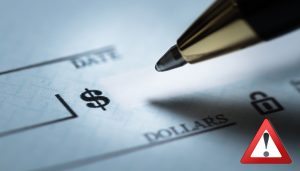Check Fraud and How to Prevent It
Though check usage has declined, check fraud has noticeably increased across the country. It is now a widespread crime that takes education, initiative, and diligence to combat.
What is check fraud?
In simple terms, check fraud is any unauthorized use of a check for the purpose of stealing money.
There are a variety of ways that criminals can gain access to your funds through check fraud, but one of the most prevalent is mail-related fraud. Perpetrators steal checks right out of mailboxes -including the official blue USPS mailboxes- and use a technique called “washing,” in which common chemicals are used to remove the ink in which the check is written. From there, they either fill the check out for whatever amount and to whomever they choose or take it to the dark web and sell the check to others who will do the same.
Not only does check fraud impact your finances, but it can compromise your identity as well. Personal information on checks can be used to open bank accounts or take out loans in your name, and sometimes the issue can take years to resolve.
How do I prevent it?
The first and best option in your line of defense against paper check fraud is to avoid mailing paper checks altogether. Opt for digital forms of payment anytime possible. Many utility and credit card companies these days offer secure online payment portals. It is best to consult them directly for information on how to set it up.
If going digital isn’t an option and you must mail a paper check, try these three tips to help prevent your money from being stolen:
- Write your checks with a gel ink pen. Gel ink is water-based and penetrates the layers of the paper, making it harder to “wash” the ink off. Write in black ink instead of blue.

- Give your check directly to the mailman or place it in the secure drop inside of the post office. Or, in the event you must leave a check in an outside mailbox, try to verify the pickup times and drop your mail in as close as possible.
- Keep a close eye on your accounts. Take extra precaution with your bank accounts by setting up transaction alerts to get real-time notifications any time your account has activity, and don’t forget to review your monthly statement.
Is there anything else?
Yes. Though check fraud is one of the most common forms of mail fraud, here are some additional scenarios to watch out for:
- If someone you don’t know or trust unexpectedly sends you a check, do not cash the check until you have verified why you received it. A very common form of fraud is when scammers overpay for goods or services, then claim they made a mistake and ask for money back. While their original check is still processing (or may even be credited to your account), you write a check to them for the amount requested and send it back. Their original check bounces or is found to be fraudulent, but you have already sent them a good check and your money is lost.
- Be cautious with sweepstakes or giveaway notices you receive in the mail or by phone. In these scams, you will be notified that you’ve won a trip, money, or some other prize. You will be instructed to send money to cover taxes, shipping, or processing fees associated with claiming your prize. Once they have your money, you won’t hear from them again. Only trust contests from reputable sources and be skeptical if you’ve “won” something without being able to remember if you applied. If it feels too good to be true, it usually is.
Though scams have gotten more creative, staying aware and acting with caution are helpful approaches in safeguarding your sensitive information and finances. Opt for secure digital ways to send payment, or do your best to minimize the vulnerability by handing your letter directly to the post office.
And remember – if you’re ever unsure or you know you have fallen victim to a scam, please alert the bank immediately. We are happy to help.